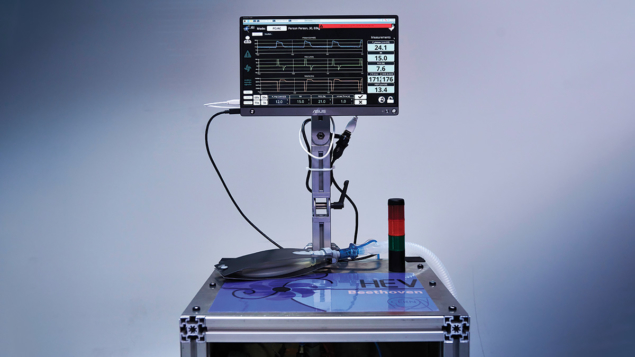
A versatile ventilator to help combat COVID-19 developed by members of the LHCb collaboration is to be re-engineered for manufacture and clinical use. The High Performance Low-cost Ventilator (HPLV) is designed to assist patients in low- and middle-income countries suffering from severe respiratory problems as a result of COVID-19. Following the award of £760,000 by UK Research and Innovation, announced in December, Ian Lazarus of the Science and Technology Facilities Council’s Daresbury Laboratory and co-workers aim to produce and test plans for the creation of an affordable, reliable and easy to operate ventilator that does not rely so heavily on compressed gases and mains electricity supply.
“I am proud to be leading the HPLV team in which we have brought together experts from medicine, science, engineering and knowledge transfer with a shared goal to make resilient high-quality ventilators available in areas of the world that currently don’t have enough of them,” said Lazarus in a press release.
While the majority of people who contract COVID-19 suffer mild symptoms, in some cases the disease can cause severe breathing difficulties and pneumonia. For such patients, the availability of ventilators that deliver oxygen to the lungs while removing carbon dioxide is critical. Commercially available ventilators are typically costly, require considerable experience to use, and often rely on the provision of high-flow oxygen and medically pure compressed air, which are not readily available in many countries.
The HPLV takes as its starting point the High Energy physics Ventilator (HEV), which was inspired by an initiative at the University of Liverpool and developed at CERN in March 2019 during the first COVID-19 lockdown. The idea emerged when physicists and engineers in LHCb’s vertex locator (VELO) group realised that the systems which are routinely used to supply and control gas at desired temperatures and pressures in particle-physics detectors are well matched to the techniques required to build and operate a ventilator (CERN Courier May/June 2020 p8). HPLV will see the hardware and software of HEV adapted to make it ready for regulatory approval and manufacture. Project partners at the Federal Institute of Rio de Janeiro in Brazil – in collaboration with CERN, the University of Birmingham, the University of Liverpool and the UK’s Medical Devices Testing and Evaluation Centre – will now identify difficulties encountered when ventilating patients and pass that information to the design team to ensure that the HPLV is fit for purpose.
“We warmly welcome the HPLV initiative, and look forward to working together with the outstanding HPLV team for our common humanitarian goal,” says Paula Collins, who co-leads the HEV project with CERN and LHCb colleague Jan Buytaert. The HPLV is one of several HEV offshoots involving 25 academic partners, she explains. “In December we also saw the first HEV prototypes to be constructed outside CERN, at the Swiss company Jean Gallay SA, which specialises in engineering for aerospace and energy. We have continued our outreach worldwide, and in particular wish to highlight an agreement being built up with a company in India that plans to modify the HEV design for local needs. None of this would have been possible without the incredible support and advice received from the medical community.”





